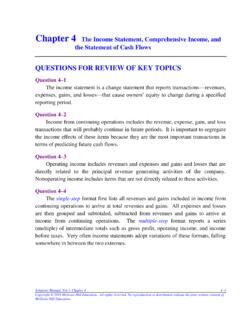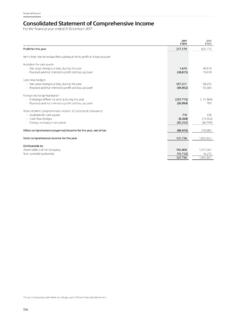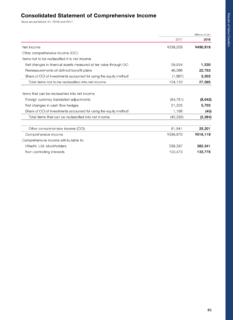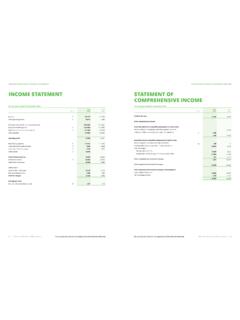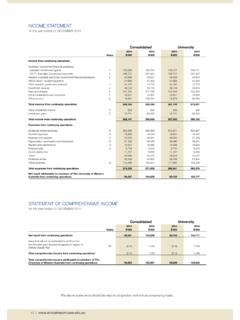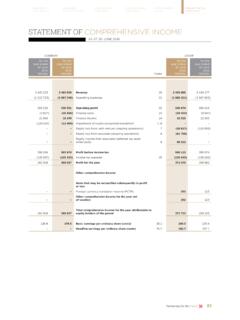Transcription of IFRS brings a radical change to financial statement ...
1 CMA MANAGEMENT28 February 2009 IFRS brings a radicalchange to financialstatementpresentationCMA MANAGEMENT29 February 2009discussion paper released by internationalaccounting regulators is proposing to change thelook and feel of financial statements. The newfinancial statement presentation is a proposal by ajoint committee of the key regulators involved in theinternational standards the Federal AccountingStandards Board (FASB) and the International AccountingStandards Board (IASB). After years of deliberation since2002, the committee released a preliminary 168-pagediscussion paper in October 2008 identifying changes tofinancial statement presentation.
2 The public has up untilApril 14, 2009, to comment on the proposal, after which itwill become an exposure draft and then move to become anew financial reporting change the look of financial statements?The two regulatory boards are proposing a new look andfeel to the statements, consistent with their objective ofimproving financial reporting and providing betterinformation to the users of financial statements. Thediscussion paper explains that how an entity presentsinformation in its financial statements is vitally importantbecause financial statements are a central feature offinancial reporting a principal means of communicatingfinancial information to those outsidean entity.
3 1 The Boards contend thatthe existing presentation guidelinesmake it difficult to understand therelationship between financialstatements and that information indifferent statements is inconsistentlypresented. These factors make itdifficult to properly assess the financialhealth of an organization. There are three objectivesassociated with the should be presented in thefinancial statements in a manner that: (a) Portrays a cohesive financialpicture of an entity s activities. Acohesive financial picture meansthat the relationship between itemsacross financial statements is clearand that an entity s financialstatements complement each other as much as possible.
4 (b) Disaggregates information so that it is useful inpredicting an entity s future cash flows. (c) Helps users assess an entity s liquidity and are the statements changing?The financial statements will have new names: an incomestatement will now be called a statement of ComprehensiveIncome and a balance sheet will be called a statement ofFinancial Position. The required statement of retainedearnings will be replaced by a statement of Changes inShareholder s Equity (Exhibit 1). There is also a newstatement reconciling net income to cash flow which must beincluded in the financial statement new names though, are just the beginning.
5 In order toachieve the objective of cohesiveness between the statements,the format of the statements will change . All statements areto be subdivided into the same general categories abusiness section (subdivided further into operating andinvesting components), a financing section, income taxes,discontinued operations, and equity (Exhibit 2). Theseclassifications are similar to how today s cash flowstatement is having a balance sheet that doesn t look like it balances. If there isone thing that accountants are used to doing it is quickly glancing at abalance sheet to see that the total assets equal the total of the liabilitiesplus equity.
6 With the introduction of International financial ReportingStandards (IFRS) in 2011 though, it may not be as easy to see that abalance sheet Karine Benzacar, CMAE xhibit 1: Complete set of financial statementsIncome StatementBalance SheetStatement of Retained EarningsStatement of Cash FlowsStatement of ComprehensiveIncomeStatement of financial PositionStatement of Changes in EquityStatement of Cash FlowsAThe new balance sheet ( statement of FinancialPosition)The biggest difference with the new format of the Statementof financial Position (balance sheet) is that at first glance, itisn t obvious that assets balance to liabilities plus equity.
7 Thetraditional balance sheet shows assets on the left side withliabilities and equity on the right, having identical totals onboth sides. The new format does not separate assets andliabilities into distinct sections. Instead, assets and liabilitiesare netted together in each of the sections (operating,investing, financing, income taxes, and discontinuedoperations) of the statement of financial Position. Howmanagement segregates assets or liabilities into each of thedifferent sections is subject to a fair bit of managementjudgment and their basis for classification must be disclosedin the financial statement notes.
8 Totals for short-term andlong-term assets in each section of the statement areoptional. An entity must disclose the totals for short-term,long-term, and total assets and liabilities but they can do soeither in the statement or in the notes to the financialstatements. There is no familiar total for liabilities plusequity (Exhibit 3). Underlying the presentation format, thebalance sheet still new income statement ( statement ofComprehensive income )The statement of comprehensive income is similar totoday s income statement in that it calculates a subtotal fornet income and then has a section for other comprehensiveincome (OCI).
9 However, everything above net income isdivided into the same categories that the balance sheet isclassified in an operating section, an investing section, afinancing section, income taxes, and discontinuedoperations. Within the OCI section, the entity must indicateto which category (operating, investing, or financing) theactual line items relate to. Line items are further identified by function and thennature. For example, cost of goods sold must be furthersubdivided into materials costs, labour costs, and for general and administrative expenses must also bedisclosed. If these guidelines result in too lengthy of astatement, the entity can summarize the statement , but theymust still present the details in the financial statement notes(Exhibit 4).
10 The new cash flow statement The Cash Flow statement is the only statement that willretain its existing name. Its format is similar to today sformat, but there is one significant change the indirectmethod of reporting cash flow will no longer be GAAP allows entities to report cash flow usingeither a direct or an indirect method. The direct methodreports cash changes based on how much cash is paid for orreceived as a result of various activities; the indirect methodstarts with income and making adjustments to arrive at cashflow. Most organizations opt to report under the indirectmethod since information for this format is usually moreeasily available from their accounting systems.
